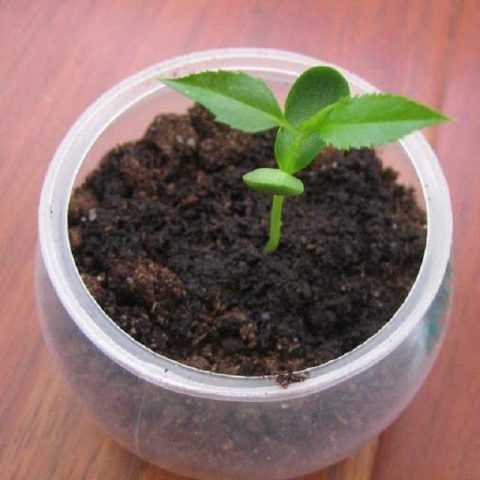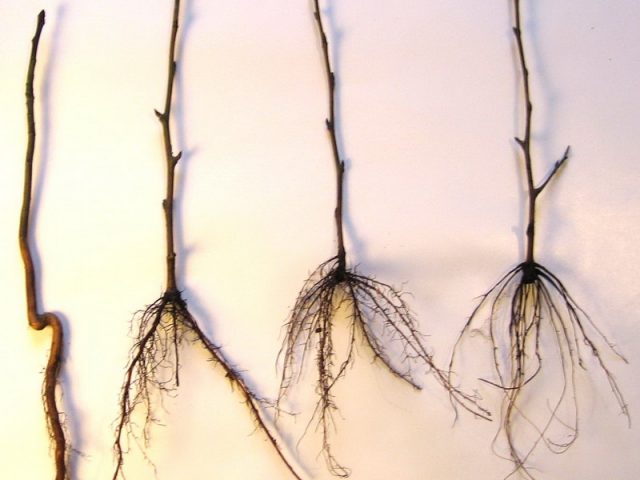Content
- 1 Is it possible to grow a pear from a seed
- 2 How to grow a pear from a seed at home
- 2.1 Seed preparation
- 2.2 Seed selection
- 2.3 Preparing for stratification
- 2.4 Stratification
- 2.5 Selection and preparation of planting containers
- 2.6 Soil preparation
- 2.7 Landing rules
- 2.8 Sprout care
- 2.9 Optimum temperature and humidity
- 2.10 Watering and feeding
- 2.11 Picking
- 2.12 Preparing to disembark
- 2.13 Open ground transplant
- 3 Experienced gardening tips
- 4 Conclusion
Most gardeners grow fruit trees from ready-made seedlings. This method of planting gives confidence that after the allotted time they will yield a crop according to varietal characteristics. But there are enthusiasts who want to grow a tree from a seed - to see how it germinates and develops, to try to get a copy that retains the characteristics of the parent plant. Is it possible to grow a pear from seeds and how to do it correctly, will be discussed further.
Is it possible to grow a pear from a seed
Like many garden trees, the pear can be grown and propagated by seed. From the planted seed, you can grow wild with tasteless fruits or a tree that is in no way inferior to the mother plant, or even surpasses it in varietal qualities. True, the probability of such an outcome is one chance in a thousand. On various forums, you can find a lot of reviews about the results of growing pears from seeds, gardeners note with satisfaction that the fruits are obtained, although smaller in size, but of good taste. The factor of chance is very strong here: having planted a seed, you do not know what will turn out to be grown from it. If the result does not meet expectations, a bud or a stalk from a tree that has already shown itself in terms of fruiting and yield can be grafted onto a young pear.
Most often, seedlings are grown from pear seeds, which will later be used as a rootstock. They are strong, hardy and immune to many diseases. Without waiting for the fruits, they are grafted, turning the wild into a cultivated plant. So gardeners strive to grow a seedling of the desired variety on a rootstock that has undergone natural selection and hardening. There is also the practice of growing dwarf pears and bonsai from seed for home decoration, then harvesting is not the goal.
How to grow a pear from a seed at home
In order to grow a healthy and strong pear seedling from a seed, you need to follow the sequence of steps when planting and provide the seedling with proper care.
Seed preparation
Having set out to grow a pear from a seed, you should be patient. The process begins with the selection of seed and its pre-planting. The final result largely depends on the quality and correct preparation of the seeds. It is preferable to select seeds of pears of zoned varieties adapted to the local climate, then the chances of growing a healthy strong seedling increase many times over.
Seed selection
To grow a pear, seeds are harvested at the end of autumn. They are harvested by hand from ripe fruits grown on the crown periphery of healthy, high-yielding trees. The seeds should be full-bodied, dense, with a shiny smooth skin. First, they are immersed in cool salty water (30 g per 1 liter), the emerging are discarded. Then they are washed in hot water, they are completely freed from fruit pulp and juice, which can serve as a favorable environment for the development of pathogenic microflora when laying for stratification. Finally, pear seeds are dried in room conditions.
Preparing for stratification
Stratification - keeping seeds in conditions of low positive or small negative temperatures in order to overcome the state of dormancy. In order to grow a pear from seeds, this stage is necessary; without stratification, they will not germinate. Before starting the procedure, pear seeds should be kept for 4-5 hours in a solution of potassium permanganate and 1 day in a growth stimulator "Epine", "Zircon".
Stratification
Pear seed stratification to grow a healthy tree takes 3 months. Seeds are processed in one of four ways:
- Mixed with wet sand, peat, sawdust and transferred to a room with a temperature of + 3-5 С. As it dries, the substrate is moistened.
- Placed in a linen bag, kept damp for 2-3 days, removed, packaged in plastic bags and stored in the refrigerator. Once a week, the pear seeds need to be mixed and moistened when drying.
- They cover it with earth, put it in a plastic box or bag and bury it in the garden at a depth of 10-15 cm. The soil surface is covered with sawdust, spruce branches or special material.
- Podzimny sowing is carried out to a depth of 4 cm, followed by shelter. Pear seeds, from which it is planned to grow a tree, are embedded directly into the ground or placed in peat pots, which are dug in flush with it. Sowing time is the onset of the first frost. The grooves in the ground are made in advance, while it has not yet set with a crust, they are covered with a dry mixture of sand, humus and ash, prepared in separate containers. Shelter with mulch is a must. This is the natural stratification of seeds.
Growing pears in containers accelerates its development and the onset of the fruiting period.
In the course of stratification in the ground, pear seeds must be protected from damage by rodents. To do this, they need to be covered with a fine mesh. If some of the seeds have sprouted too early, the whole batch is transferred to a room with a temperature of 0-1 ˚С. This will delay their further development, while the rest will ripen.
Selection and preparation of planting containers
By spring, stratified pear seeds will hatch, then they need to be grown in greenhouse conditions. As a container, use special containers or cups from yogurt, sour cream, ice cream. Clay flower pots are also suitable - they must be soaked in water for 24 hours before use. The container for growing pears from seeds must be washed with a disinfectant solution of potassium permanganate before sowing, make holes for the outflow of moisture and place a drainage from pebbles or perlite on the bottom. No preparation is required when using peat pots.
Soil preparation
The soil for germinating pear seeds must be nutritious. You can buy soil specially designed for this purpose, but ordinary garden soil enriched with fertilizers will do. For 10 kg, add 200 g of ash, 30 g of superphosphate and 20 g of potassium sulfate and mix. It is recommended to disinfect the soil mixture - put it on a baking sheet with a layer of 1.5-2 cm and stand for 1 hour in an oven preheated to 125 ° C. Then it is poured over the drain, filling the container by ¾.
Landing rules
To grow high-quality seedlings, the strongest of the germinated seeds are selected for sowing. They need to be laid carefully so as not to break the shoots, to deepen them by 1-1.5 cm. Deeper embedding will lead to the formation of a non-viable plant that will die for 2-3 years. A distance of 5-7 cm is observed between the seeds. In the pots, holes are made for 4-5 seeds, grooves are made in large containers and sown sparsely.The soil is moistened with a spray bottle, the container is covered with glass or foil and placed in a bright place - on a windowsill or an insulated balcony on the sunny side. Crops should be aired daily and watered as needed. A crust should not be allowed to appear on the surface of the soil - the shoots will not be able to break through it.
Sprout care
A month later, cotyledons will appear above the surface of the earth, and then real leaves. When their number reaches 4, the seedlings can be transplanted into separate larger pots. Carefully, so as not to damage the fragile roots, the seedlings are removed with a lump of earth and placed in pre-prepared holes.
Optimum temperature and humidity
Seedlings should be grown at a temperature of 18-20 ° C and a relative humidity of at least 60%. Every day you need to ventilate the room for hardening the pear several times a day for 5-10 minutes. Avoid direct sunlight on young growth and movement of drafts in the room.
Watering and feeding
Watering pear seedlings should be quite frequent - in dry sunny weather every day, in cloudy, rainy weather - every other day. Crops should be fed three times with a solution of ammonium nitrate, mullein or bird droppings in a ratio of 1:10. The first time - at the beginning of growth, the second - after the first shoots, the third - a month later.
Picking
When thickening, the seedlings need to be thinned twice - when the first true leaves are formed and after another 2 weeks. During this procedure, weak and twisted shoots are removed, strong ones are transplanted into the vacated places. The pick is carried out after watering or rain. A third of the spine is removed from the sprouts, dipped in a clay mash and planted at an interval of 7 cm.
Preparing to disembark
Young pears need to be prepared for outdoor cultivation. A week before disembarkation, the containers are taken out into the open air for half an hour. For easier removal of the seedlings from the container, the soil is soaked in it.
Open ground transplant
Well-lit and wind-protected areas are suitable for planting young pears. The soil should be loose, water and air permeable. The seedlings are buried 3-4 cm, watered with warm water, mulched with sawdust. Watering is carried out as the soil dries up. The distance between the plants is 8 cm, the row spacing is 10 cm. After planting, young pears need regular watering, loosening, weeding and feeding. For the first 2 months, the tree intensively forms roots, therefore it slowly grows. Pre-grafting plant care aims to ensure strong growth and the formation of an active, healthy cambium and bark. A strong rootstock allows a healthy, strong tree to be grown with due care.
Experienced gardening tips
There are many opinions on how to grow a pear from seed - they cover every stage, from stratification to placement in a permanent place in the garden. Some gardeners recommend storing seeds until spring in a wet substrate, others in dry sand. Many people choose to sow seeds directly into the soil in the fall, believing that nature will take best care of selecting the strongest and most hardened samples. To grow a pear in greenhouse conditions in winter, some recommend taking it to a permanent place or to a "school" in the spring, others in September, when the seedling gets stronger, and still others in a year, which accelerates the onset of fruiting. All these opinions are based on their own experience and a novice gardener will have to choose a planting method that will allow them to grow a pear tree from a seed.
Conclusion
Growing a pear from seeds is a long and laborious task with unpredictable results. Experienced gardeners use this method to obtain strong frost-resistant rootstocks. Enthusiasts and experimenters strive to grow a dream tree from pear seeds, which will become a decoration of a garden or home interior.To achieve a good result, you need to carefully look after the young tree - cover it from frost and rodents, protect it from parasites, feed, loosen and weed the ground. Only by performing the necessary measures, it is possible to grow a full-fledged healthy tree from a pear seed.












